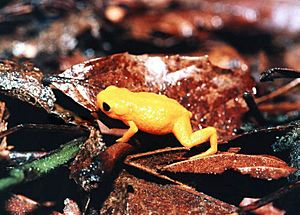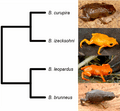Saddleback toad facts for kids
Quick facts for kids Saddleback toads |
|
|---|---|
 |
|
| Spix’s saddleback toad, Brachycephalus ephippium | |
| Scientific classification | |
| Kingdom: | |
| Phylum: | |
| Class: | |
| Order: | |
| Suborder: | |
| Family: |
Brachycephalidae
Günther, 1858
|
| Genus: |
Brachycephalus
|
The saddleback toads are a group of very small frogs. They belong to the family called Brachycephalidae. There is only one main group, or genus, within this family, and it's named Brachycephalus. Scientists have found 28 different kinds, or species, of these tiny toads.
Contents
What Are Saddleback Toads?
These little frogs are usually yellow. They are very small, often about 1 centimetre (0.39 in) long. Some are even smaller! For example, the Brazilian golden frog (Brachycephalus didactylus) is the smallest frog in the southern part of the world.
Saddleback toads have a special feature. They only have three toes on each foot. They also have two fingers on each hand. This is different from most frogs, which usually have five toes and four fingers.
Where Do They Live?
These tiny frogs live in the cool, misty Atlantic forests of southeastern Brazil. These mountain areas have many different species. In fact, they have more species per square kilometer than even the Amazon basin.
Each small mountain often has its own unique species of saddleback toad. This happens because these frogs are very sensitive to their surroundings. Even a small change in temperature from a mountain top to a valley can create a barrier. This barrier keeps groups of frogs on different mountains separate. Over time, these isolated groups slowly develop into their own distinct species.
Life Cycle and Habits
Saddleback toads are active during the day. They live on the forest floor, hiding in the fallen leaves.
A unique thing about these frogs is how they reproduce. Their eggs hatch directly into tiny frogs. There is no tadpole stage, which is common for most frogs. The eggs are laid on the ground. They are covered with soil. This helps protect them from heat and from animals that might try to eat them.
Images for kids
See also
 In Spanish: Brachycephalus para niños
In Spanish: Brachycephalus para niños







